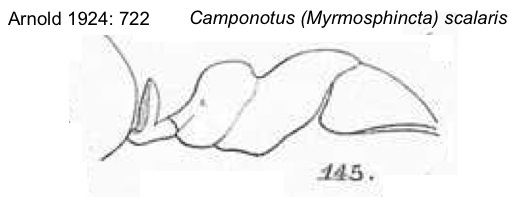Camponotus (Myrmonesites) scalaris Forel
  Type location South
Africa (Camponotus scalaris
nov. sp., Forel, 1901d: 308, major & minor workers & queen)
collected
in Natal, at 1800m, by Haviland; major & minor workers & queen
only known
(see Bolton, 1995) Type location South
Africa (Camponotus scalaris
nov. sp., Forel, 1901d: 308, major & minor workers & queen)
collected
in Natal, at 1800m, by Haviland; major & minor workers & queen
only known
(see Bolton, 1995)  . .
|
 Major - TL
7.0-8.2 mm; shoulders of pronotum apparently
rounded, metanotal suture deep and propodeum dorsum much lower than
mesonotum; pilosity greyish-yellow, very sparse except on gaster,
thicker and longer on propodeum and petiole; dull, gaster moderately
shiny; black, appendages and anterior of head dark red, tarsi brownish Major - TL
7.0-8.2 mm; shoulders of pronotum apparently
rounded, metanotal suture deep and propodeum dorsum much lower than
mesonotum; pilosity greyish-yellow, very sparse except on gaster,
thicker and longer on propodeum and petiole; dull, gaster moderately
shiny; black, appendages and anterior of head dark red, tarsi brownish
Minor - TL 4.7-6 mm; stepping of propodeum even more pronounced.
Bolton (1995:122) lists the history of the subgenus
placement
as - "Combination in C. (Myrmosphincta) Forel, 1912i: 92; in C.
(Orthonotomyrmex) Emery, 1920b: 258; in C. (Myrmisolepis)
Santschi (1921f: 310: in C. (Myrmopiromis) Emery, 1925b: 129".
Given the distinctive alitrunk profile, the placement in C.
(Myrmopiromis) seems erroneous, as all other members of the
subgenus have an unbroken alitrunk profile, the only variation being in
the angle between the dorsum and declivity of the propodeum. The
combination in C. (Myrmisolepis) makes sense in terms of the
alitrunk having an interrupted profile but the four members do not have
an incised metanotal suture and the propodeums have an angular profile
with a near flat dorsum and vertical to slightly concave declivity. C.
(Orthonotomyrmex) do have an incised metanotal suture but with the
exception of the aberrant scabrinodis have a low nodular
petiole; scabrinodis has a strange erect node with a convex
anterior face, a flat posterior face and the border unique in having
several short teeth. Arnold (1922: 722) had it in C.
(Myrmosphincta) [Forel, A. 1912i. Formicides Neotropiques. Part 6.
5me sous-famille Camponotinae Forel. Mem. Soc. Entomol. Belg. 20,:
59-92 HNS 4044]. Most of the species listed by Forel, who acknowledged
this was not a natural grouping, were from South Asia and Australia,
with three or so from the Neotropics/Caribbean but reaumuri and
imitator (Forel, 1891b: 209) were from Madagascar.
The subgenera C. (Myrmonesites) and C. (Myrmoptia) were
later erected (Emery, 1920b: 243); the latter has the strange species imitator
with an elongated narrowly waisted alitrunk. Camponotus
reaumuri was
placed (Emery, 1920b: 257) in C. (Myrmonesites).
|
Forel's (1901d) description is at  . Arnold (1924: 722) gave an illustrated
translation, as Camponotus
(Myrmosphincta) scalaris; this is at . Arnold (1924: 722) gave an illustrated
translation, as Camponotus
(Myrmosphincta) scalaris; this is at  . .
In comparison with leveillei and reaumuri
-
the first has a quite narrow petiole profile similar to that of scalaris
and the second has the deep metanotal suture and domed propodeum.
|